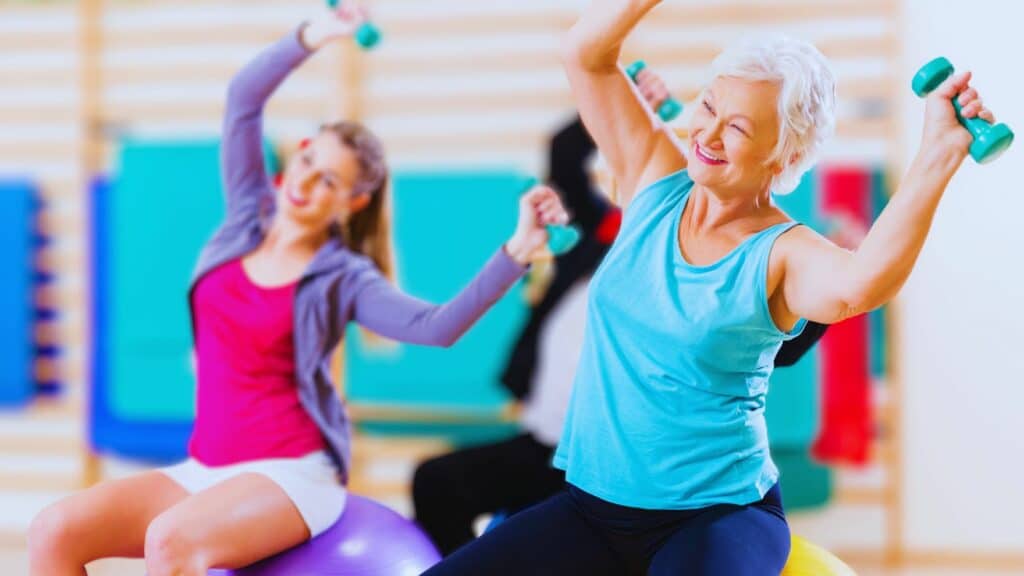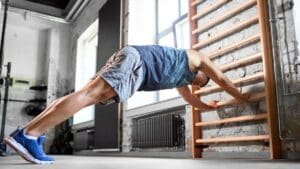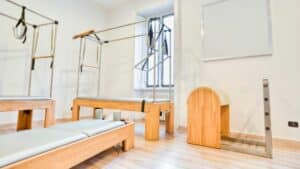
In an era where aging often means slowing down, functional fitness shines as a beacon of hope, redefining the art of aging gracefully. For seniors, it’s not just about extending life, but enriching it with vitality.
Let’s take a closer look at what makes functional fitness an ideal match for seniors – blending strength, balance, and flexibility into a lifestyle where each movement is meaningful. More than just exercise, it’s about empowering seniors to live vibrant, independent lives, handling everyday tasks with ease and confidence.
What is Functional Fitness?
Functional fitness prepares the body for real-life activities, contrasting conventional gym workouts that often isolate specific muscles. This holistic training simulates everyday movements, incorporating strength, balance, coordination, and flexibility.
For seniors, this approach is crucial. It’s less about heavy lifting or speed, and more about improving daily life quality. Activities like stair climbing, grocery carrying, or playing with grandchildren become easier. By mirroring daily tasks, functional fitness enhances the ability to perform these activities independently, essential for a rewarding senior lifestyle.
Why Functional Fitness is Essential for Seniors
Functional fitness offers extensive benefits beyond physical health for seniors. As we age, we naturally lose muscle strength, flexibility, and balance, leading to increased fall risks and mobility decline. Functional fitness counters these age-related issues by:
- Improving Balance and Stability: Core strength and balance-focused exercises reduce fall risks.
- Enhancing Strength and Mobility: Regular functional exercises boost muscle strength and joint mobility, making daily tasks more manageable.
- Mental Health Benefits: It can diminish anxiety and depression symptoms, enhance cognitive functions, and foster a sense of accomplishment.
- Promoting Independence: Physical capability improvements empower seniors to maintain their independence, crucial for life quality.
- Providing Physiological Benefits: Supporting cardiovascular health, aiding arthritis and osteoporosis management, and helping regulate blood sugar levels.
Functional fitness is a comprehensive approach to healthy aging, ensuring seniors live not just longer, but with vitality and independence.
Key Functional Exercises for Seniors
Functional fitness for seniors targets core strength, balance, flexibility, and overall mobility. Here are some specific exercises:
- Developing Core Strength and Balance: Core stability is essential for balance and fall prevention. Functional core exercises like seated twists enhance core muscle endurance, while standing leg lifts improve balance, reducing the risk of falls during everyday activities.
- Enhancing Flexibility: Flexibility exercises help maintain a range of motion, which is key for preventing injuries. Gentle stretching routines and yoga poses can alleviate stiffness, improve posture, and make daily movements like reaching and bending smoother.
- Building Overall Mobility: Exercises that simulate daily activities keep the body agile and responsive. For instance, activities like walking or light gardening help maintain functional mobility, ensuring tasks like climbing stairs or carrying groceries remain manageable.
With these basics in mind, here are more structured exercises:
- TRX Suspension Training: TRX exercises use suspension training to improve strength and flexibility. For seniors, exercises like TRX squats not only strengthen the lower body but also enhance joint stability, crucial for movements like sitting down and standing up.
- Pilates: Ideal for seniors, this low-impact regimen enhances muscle strength, flexibility, and balance. Focusing on the core, seniors that do Pilates also enjoy reduced fall risks and easier daily activities, making it an optimal choice for maintaining health and mobility.
- Yoga with Weights: This combines the flexibility benefits of yoga with the strength training of light weights. Sequences like the warrior pose, when combined with weights, build lower body strength and improve balance, aiding in activities like walking and stair climbing.
- Calisthenics: These bodyweight exercises are adaptable and safe for seniors. Simple calisthenics exercises like step-ups and wall push-ups help build upper and lower body strength, making everyday tasks like lifting and pushing easier.
- Walking and Light Cardio: Regular, moderate-paced walking is excellent for maintaining cardiovascular health and overall endurance. Consistent walking helps improve stamina, ensuring seniors can engage in activities for longer periods without fatigue.
- Resistance Bands: Incorporating resistance bands into fitness routines adds a level of gentle yet effective resistance. This helps improve muscle tone and joint flexibility, key factors in performing daily tasks with ease and reducing the risk of muscle atrophy.
Starting with exercises that align with current fitness levels and gradually increasing intensity under professional guidance is key for seniors.
Tailoring Functional Fitness to Individual Needs
Before diving into functional fitness, it’s a wise move for seniors to touch base with their doctor. Informing healthcare providers about the intention to start a functional fitness routine allows for valuable medical advice, especially on exercises to avoid or modify based on individual health conditions. Once this crucial step is taken, customizing workouts to fit personal health conditions, fitness levels, and goals becomes more effective and safer. Here’s how seniors can tailor their functional fitness routines:
- Assessing fitness levels with a health professional.
- Considering chronic conditions in exercise choice.
- Setting realistic, SMART goals.
- Mixing exercises for a well-rounded approach.
- Adjusting exercise intensity and duration.
- Seeking professional guidance for personalized modifications.
Personalizing functional fitness routines enables seniors to enjoy maximum benefits while minimizing risks, paving the way for a fulfilling and sustainable fitness journey.
Incorporating Functional Fitness into Daily Life
Who says you need a gym full of equipment to stay fit? For seniors, making your home your gym can be both effective and convenient. Integrating functional fitness into everyday life is essential for maximizing its benefits. This involves creatively blending exercises into regular activities, thereby making fitness an integral, seamless part of daily life. Here are some practical strategies to achieve this:
- Start with Daily Tasks: Turn everyday activities into exercise opportunities, like opting for stairs over elevators or doing calf raises while at the sink.
- Create a Routine: Establishing a daily exercise routine helps in forming lasting habits. Dedicate specific times for workouts, whether it’s for morning stretches or an evening walk.
- Utilize Household Items: Transform common household items into exercise tools. Chairs can be used for seated exercises, and canned goods can double as light hand weights.
- Stay Active Throughout the Day: Encourage constant movement, such as walking while talking on the phone or stretching during TV breaks.
- Set Incremental Goals: Approach exercises in small, achievable steps, like gradually increasing daily steps or adding more exercise repetitions over time.
- Socialize Through Fitness: Adding a social element, like group classes or walking with friends, can enhance motivation and make fitness more enjoyable.
By embedding functional fitness into their daily lives, seniors can significantly improve their health and well-being, turning everyday situations into opportunities for maintaining fitness.
Safety First: Precautions Tips for Seniors
When it comes to functional fitness, safety is paramount, especially for seniors. As they incorporate exercises into their routines, certain precautions are necessary to prevent injuries and ensure a healthy fitness journey:
- Consulting healthcare providers before starting new exercises.
- Incorporating warm-up and cool-down routines.
- Listening to the body and avoiding overexertion.
- Focusing on proper exercise form.
- Maintaining hydration and proper nutrition.
- Creating a safe exercise environment.
- Progressing gradually in intensity and duration.
By adhering to these safety guidelines, seniors can enjoy the benefits of functional fitness while minimizing the risk of injury, ensuring a safer and more enjoyable path to health and independence.
Nutrition’s Role in Functional Fitness
For seniors engaging in functional fitness, nutrition is key. A balanced diet rich in proteins, healthy fats, and hydrating fluids is crucial for muscle maintenance, joint health, and energy levels. Proteins are vital for muscle repair, hydration aids exercise performance, and healthy fats support joint health and energy. Proper nutrition is the foundation for successful fitness, aiding in both performance and recovery.
Leveraging Technology in Functional Fitness for Seniors
In today’s digital age, technology plays a significant role in enhancing functional fitness. From tracking progress to providing motivation, technological tools can greatly assist in a senior’s fitness journey.
- Fitness Trackers and Apps: Wearable devices like fitness trackers monitor steps, heart rate, and even sleep patterns. Apps can help set exercise goals, track progress, and provide reminders, making it easier to stay on track.
- Online Exercise Programs: Various online platforms offer exercise programs tailored for seniors. These programs often include video tutorials that demonstrate proper exercise techniques, which is particularly useful for those who prefer exercising at home.
- Virtual Classes and Communities: Technology enables seniors to join virtual fitness classes or communities, fostering a sense of connection and motivation. Participating in online groups can also provide support and encouragement from peers.
- Smart Home Equipment: Smart exercise equipment, such as stationary bikes or treadmills with interactive features, can make workouts more engaging. These devices often come with built-in programs that adapt to a user’s fitness level.
- Safety and Monitoring Devices: Wearable emergency alert systems and GPS devices can provide peace of mind for both the seniors and their families, especially for those who exercise outdoors.
By incorporating technology into their functional fitness routines, seniors can not only track and improve their exercise regimen but also enjoy a more connected and safe exercise experience.
Final Thoughts
For seniors, functional fitness is more than just exercise; it’s about embracing a lifestyle that keeps us vibrant, agile, and connected. It’s a celebration of what our bodies can still achieve, no matter our age. It’s about laughing a little louder in yoga class, sharing stories on a morning walk, or feeling the triumph of climbing stairs without a pause. It’s in these moments that we truly appreciate the blend of movement, community, and wellbeing.
So, take that first small step. Maybe it’s a gentle stretch in the morning sun or a walk with an old friend. Each step is a victory, a testament to your strength and spirit. Here’s to moving, thriving, and living life to its fullest at every age.



